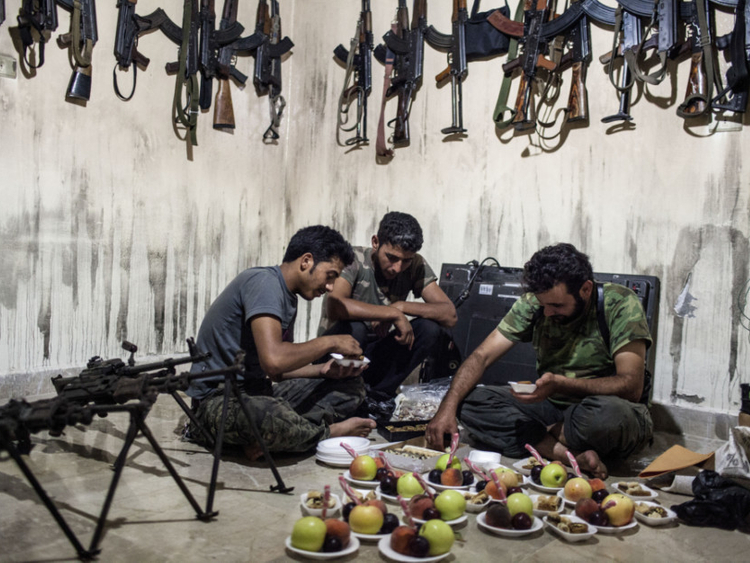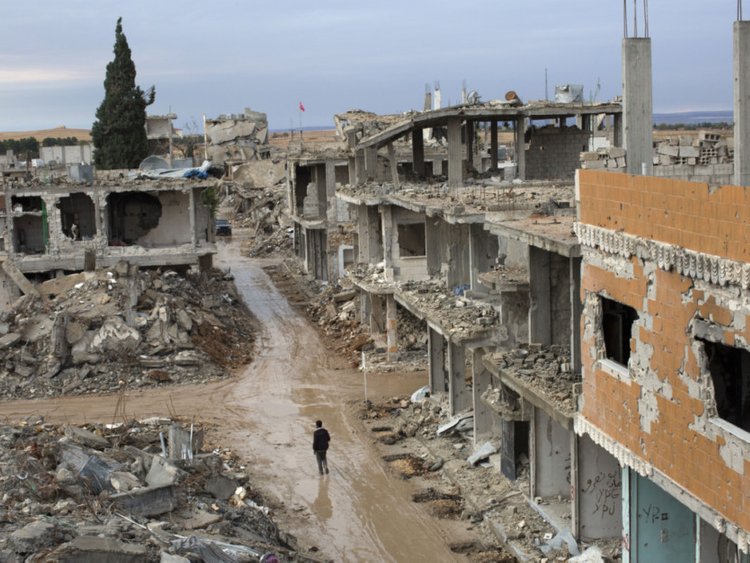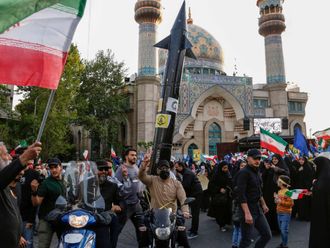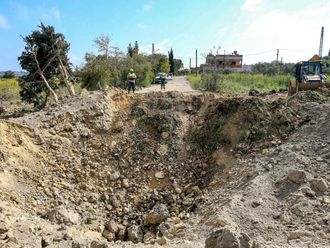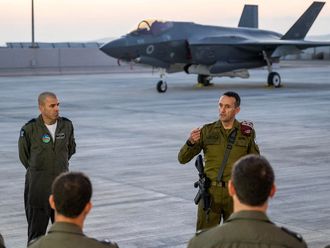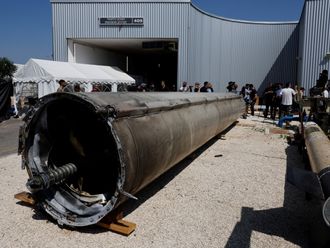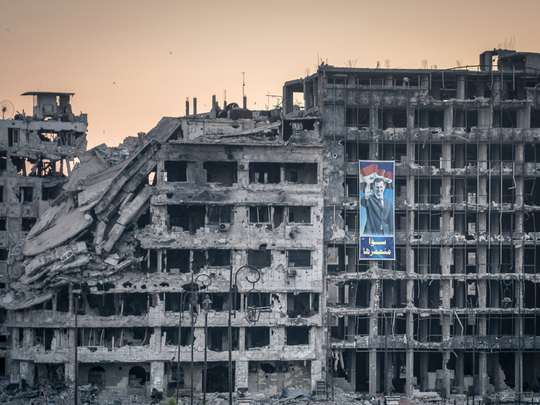
Washington: Here is a basic fact about Syria’s civil war that never seems to change: It frustrates any attempt at resolution.
Despite many offensives, peace conferences and foreign interventions, including this week’s Turkish incursion into a border town, the only needle that ever seems to move is the one measuring the suffering of Syrians — which only worsens.
Academic research on civil wars, taken together, reveals why. The average such conflict now lasts about a decade, twice as long as Syria’s so far. But there are a handful of factors that can make them longer, more violent and harder to stop. Virtually all are present in Syria.
Many stem from foreign interventions that were intended to end the war but have instead entrenched it in a stalemate in which violence is self-reinforcing and the normal avenues for peace are all closed. The fact that the underlying battle is multi-party rather than two-sided also works against resolution.
When asked what other conflicts through history had similar dynamics, Barbara F. Walter, a University of San Diego professor and leading expert on civil wars, paused, considered a few possibilities, then gave up. There were none.
“This is a really, really tough case,” she said.
Most civil wars end when one side loses. Either it is defeated militarily, or it exhausts its weapons or loses popular support and has to give up. About a quarter of civil wars end in a peace deal, often because both sides are exhausted.
That might have happened in Syria: The core combatants — the government and the insurgents who began fighting it in 2011 — are quite weak and, on their own, cannot sustain the fight for long.
But they are not on their own. Each side is backed by foreign powers — including the United States, Russia, Iran, Saudi Arabia and now Turkey — whose interventions have suspended the usual laws of nature. Forces that would normally slow the conflict’s inertia are absent, allowing it to continue far longer than it otherwise would.
This is why, according to James D. Fearon, a Stanford professor who studies civil wars, multiple studies have found that “if you have outside intervention on both sides, duration is significantly greater.”
Government and rebel forces are supplied from abroad, which means their arms never run out. They also both draw political support from foreign governments who do not feel the war’s costs firsthand, rather than from locals who might otherwise push for peace to end their pain. These material and human costs are easy for the far richer foreign powers to bear.
The ground battles also include Kurdish militias, who have some foreign backing, and Daesh, which does not. But pro-government and opposition forces are focused on one another, making them and their sponsors the war’s central dynamic.
No one can lose, no one can win
Foreign sponsors do not just remove mechanisms for peace. They introduce self-reinforcing mechanisms for an ever-intensifying stalemate.
Whenever one side loses ground, its foreign backers increase their involvement, sending supplies or air support to prevent their favoured player’s defeat. Then that side begins winning, which tends to prompt the other’s foreign backers to up their ante as well. Each escalation is a bit stronger than what came before, accelerating the killing without ever changing the war’s fundamental balance.
This has been Syria’s story almost since the beginning. In late 2012, as Syria’s military suffered defeats, Iran intervened on its behalf. By early 2013, government forces rebounded, so wealthy Gulf states flooded support to the rebels. Several rounds later, the United States and Russia have joined the fray.
These foreign powers are strong enough to match virtually any escalation. None can force an outright victory because the other side can always counter, so the cycle only continues. Even natural fluctuations in the battle lines can trigger another round.
Over the past year, for example, the United States has supported Syrian Kurds against Daesh. As the Kurds grew strong, this alarmed Turkey, which is fighting its own Kurdish insurgency. This week, Turkey intervened to seize the Syrian town of Jarabulus, backed by the United States, in part to prevent Kurds from taking it first. (The United States backed this effort, too, in case the alliances weren’t complicated enough already.)
“We tend to think this is as bad as it can get,” Walter said. “Well, no, it could get a lot worse.”
War’s structure encourages atrocities
Syria has seen repeated indiscriminate mass killings of civilians, on all sides. This is not driven just by malice, but by something more powerful: structural incentives.
In most civil wars, the fighting forces depend on popular support to succeed. This “human terrain”, as counterinsurgency experts call it, provides all sides with an incentive to protect civilians and minimise atrocities, and has often proved decisive.
Wars like Syria’s, in which the government and opposition rely heavily on foreign support, encourage the precise opposite behaviour, according to research by Reed M. Wood of Arizona State University, Jacob D. Kathman of the State University of New York at Buffalo and Stephen E. Gent of the University of North Carolina.
Because Syria’s combatants rely on foreign sponsors, rather than the local population, they have little incentive to protect civilians. In fact, this dynamic turns the local population into a potential threat rather than a necessary resource.
The incentives push them to “utilise collective violence and terror to shape the behaviours of the population,” the researchers found. The images we see of dead mothers and children may represent not helpless bystanders but deliberate targets, killed not out of madness or cruelty but out of coldly rational calculation.
Severe, indiscriminate attacks on civilians bring little near-term risks and substantial benefits: disrupting the enemy’s control or local support, pacifying potential threats, plundering resources and others.
Pro-government forces have conducted by far the most attacks against civilians, but opposition fighters have led some as well. Among the insurgents, individual groups that refuse to attack civilians end up at a disadvantage compared with the groups that will.
Fear of defeat entrenches a terrible status quo
Stalemate is also driven by uncertainty. No one is sure what a post-war Syria would look like or how to get there, but everyone can imagine a worse situation. This creates a status quo bias, in which combatants are more worried about preserving what they have than risking it to pursue their broader goals.
As Fearon of Stanford put it: “It’s more important to stop the other side from winning than it is to win yourself.”
Each foreign power understands it cannot win, but earnestly fears that a victory by the other side would be unbearable. Saudi Arabia and Iran, for example, see Syria as a battleground in their regional power struggle.
Even if Syria’s war hurts everyone in the long-term, guaranteeing more extremism and instability, short-term fears of defeat pull everyone toward maintaining a perpetual, unwinnable draw.
This is exacerbated by the decision-making dynamics of loose coalitions. Each side consists of several actors with wildly different agendas and priorities. Often, all they can agree on is that they wish to avoid defeat. It is strategy by least common denominator.
There is reason to believe that Russia, for example, would like Syrian President Bashar Al Assad to step down, or at least make some concessions for peace. But Russia can’t force him to act, nor can it simply quit Syria without abandoning its interests there. Al Assad, meanwhile, might want a fuller Russian intervention that brings him victory, something Moscow is unwilling to provide.
The result: Al Assad stays in place, and Russia intervenes only enough to keep him there for now.
Syrian parties are built to fight, not to win
The Syrian government and the insurgents fighting it are internally weak in ways that lead them to prefer a stalemate, no matter how terrible, over almost any viable outcome.
Syria’s top leaders belong mostly to the Alawite religious minority, which makes up a small share of the country’s population but a disproportionate share of security forces. After years of war along demographic lines, Alawites fear they could face genocide if Al Assad does not secure a total victory.
But such a victory appears extremely unlikely, in part because the Alawites’ minority status gives them too little support to restore order with anything but violence. So Syria’s leaders believe that stalemate is the best way to preserve Alawite safety today, even if that increases risks for their long-term future.
Syria’s opposition is weak in a different way. It is fractured among many groups, another factor that tends to prolong civil wars and make them less likely to end peacefully.
A study of every UN peacemaking effort since 1945 found that it succeeded in resolving two-thirds of two-sided civil wars, but only one-quarter of multi-sided ones. Syria’s battlefield is a complex polygon, with an array of Syrian rebel groups that include moderates and Islamists; affiliates of Al Qaida and Daesh; Syrian forces and outsiders such as the Lebanese Shiite militia Hezbollah; and foreign fighters who join Islamist militant groups.
Each of these factions has its own aims, which narrow the terms of any possible peace deal. Each also has an incentive to compete with other groups for resources during the war, and for concessions afterward.
This is why multi-sided oppositions tend to fail. Even if they overthrow the government, they often end up in a second war among themselves.
The dangers of victory
The only certain way to break the logjam is for one side to surge beyond what the other can match. Because Syria has sucked in two of the world’s leading military powers, Russia and the United States, that bar most likely could only be cleared by a full-scale invasion.
In the best case, this would require something akin to the yearslong US occupations of Iraq or Afghanistan. In the worst, invading a war zone where so many foreign adversaries are active could ignite a major regional war.
Another way that such wars can end is that one foreign backer changes its foreign policy and decides to withdraw. This allows the other side to quickly win.
But in Syria, because each side is backed by multiple foreign powers, every sponsor on one side would have to drop its support at the same time.
An obstacle to peace: no peacekeepers
Peace deals often succeed or fail on the question of who will control military and security forces. In Syria, this may be a question without an answer.
It’s an issue not of greed, but of trust. After a war as brutal as Syria’s, in which more than 400,000 people have been killed, the combatants reasonably fear they will be massacred if the other secures too much power. But a deal that would give the parties equal military power creates a high risk of relapse into war. So does allowing rebels to keep their arms and independence — a lesson the world learned in Libya.
At the same time, there has to be some sort of armed force to restore security and clean up any remaining warlords or militias.
Often, the solution has been for an outside country or organisation, such as the United Nations, to send peacekeepers. These forces keep everyone in check during the country’s transition to peace and provide basic security in a way that won’t spur either side to rearm.
But what country would volunteer its citizens to indefinitely occupy Syria, particularly with the cautionary tale of the United States’ experience in Iraq?
Any foreign force would make itself a target for terrorists, and likely face a years-long insurgency that could cost it hundreds or thousands of lives.
A drift into disaster
Fearon, listing the ways that Syria’s war cannot end, said that in the best case, one side would slowly grind out a far-off victory that would merely downgrade the war into “a somewhat lower-level insurgency, terrorist attacks, and so on.”
The worst case is significantly worse.
According to a 2015 paper by Walter and Kenneth M. Pollack, a Middle East expert, “Outright military victory in a civil war often comes at the price of horrific [even genocidal] levels of violence against the defeated, including their civilian populations.”
This could bring entirely new conflicts to the Middle East, they found: “Victorious groups in a civil war sometimes also try to employ their newfound strength against neighbouring states, resulting in inter-state wars.”
This is not a drift that anyone wants, but it is the direction that Syria’s many domestic and foreign participants are pulling the country, whose darkest days may still be ahead.



